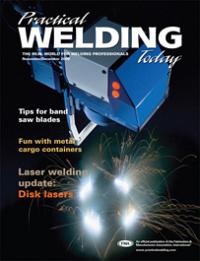Product business manager, carbon/low-alloy steel MIG wire
- FMA
- The Fabricator
- FABTECH
- Canadian Metalworking
Categories
- Additive Manufacturing
- Aluminum Welding
- Arc Welding
- Assembly and Joining
- Automation and Robotics
- Bending and Forming
- Consumables
- Cutting and Weld Prep
- Electric Vehicles
- En Español
- Finishing
- Hydroforming
- Laser Cutting
- Laser Welding
- Machining
- Manufacturing Software
- Materials Handling
- Metals/Materials
- Oxyfuel Cutting
- Plasma Cutting
- Power Tools
- Punching and Other Holemaking
- Roll Forming
- Safety
- Sawing
- Shearing
- Shop Management
- Testing and Measuring
- Tube and Pipe Fabrication
- Tube and Pipe Production
- Waterjet Cutting
Industry Directory
Webcasts
Podcasts
FAB 40
Advertise
Subscribe
Account Login
Search
Consumables Corner: Selecting filler metal for robotic welding
- By Chris Depew
- August 22, 2014
- Article
- Consumables
Q: We are just getting started in robotic welding. What advice can you give us on how to select the correct filler metal?
A: As in any high-productivity application, the main consideration in selecting a filler metal for robotic welding is performance consistency. You want a wire that will produce the same results all day, every day. In robotic applications it is often more difficult to make adjustments for variations from batch to batch. In most cases, you cannot afford the downtime to reset the machine, so you need a consistent wire.
When you are evaluating potential wires, ask to see arc-stability charts to see if the wire in question has the arc consistency you need for long-term performance.
Another consideration is available package size. Is the wire available only on spools, or do they offer bulk packaging of 800 to 1,000 lbs.? The fewer stops you need to make to change wire, the more productive you will be. Also find out the feed force required to push the wire from the package to the tip. Wires that require less force have fewer vibration and burnback issues. So ask to see the feedability charts on the wires you are considering.
You will hear many debates in the industry about copper-coated versus bare solid wire. Some believe that copper coating improves the feedability and electrical conductivity and extends the shelf life of the wire. In my experience, you can find excellent products in both types of wire that perform extremely well in robotic applications. The choice is largely a matter of personal preference.
Something you might want to consider, however, is the use of a metal-cored wire rather than a solid wire. Unlike solid wires in which the current travels through the entire wire, in metal-cored wires the current travels only through the metal sheath. This increases the current density, producing higher depression rates, better penetration, and better side-wall fusion than solid wires. Although the initial cost of metal-cored wires is greater, their higher deposition rate, faster travel speed, and reduced cleanup needs often offset the difference in price and even save money in many cases.
About the Author
Chris Depew
801 Wilson Ave. P.O. Box 517
Hanover, PA 17331
About the Publication
Related Companies
subscribe now

The Welder, formerly known as Practical Welding Today, is a showcase of the real people who make the products we use and work with every day. This magazine has served the welding community in North America well for more than 20 years.
start your free subscription- Stay connected from anywhere

Easily access valuable industry resources now with full access to the digital edition of The Fabricator.

Easily access valuable industry resources now with full access to the digital edition of The Welder.

Easily access valuable industry resources now with full access to the digital edition of The Tube and Pipe Journal.
- Podcasting
- Podcast:
- The Fabricator Podcast
- Published:
- 04/16/2024
- Running Time:
- 63:29
In this episode of The Fabricator Podcast, Caleb Chamberlain, co-founder and CEO of OSH Cut, discusses his company’s...
- Industry Events
16th Annual Safety Conference
- April 30 - May 1, 2024
- Elgin,
Pipe and Tube Conference
- May 21 - 22, 2024
- Omaha, NE
World-Class Roll Forming Workshop
- June 5 - 6, 2024
- Louisville, KY
Advanced Laser Application Workshop
- June 25 - 27, 2024
- Novi, MI
































